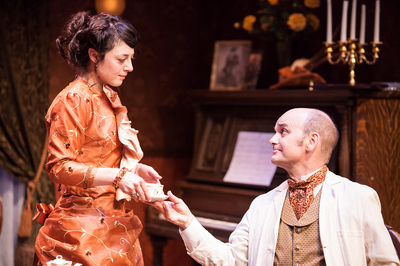Self-discovery happens 'In the Next Room' at Performance Network

John Seibert and Aphrodite Nikolovski in "In the Next Room"
photo by Sean Carter | courtesy of Performance Network
Yet this is precisely the historical moment upon which Sarah Ruhl’s “In the Next Room, or the vibrator play,” now playing at Performance Network, focuses. Set in a spa town outside New York City in the 1880s, “Next Room” takes place in the home and “operating theater” of Dr. Givings (John Seibert). Givings’ young wife Catherine (Aphrodite Nikolovski) is a lonely new mother whose body isn’t producing enough milk to nurse the baby sufficiently; and Givings is a fanatic about electricity, which he employs for the purposes of relieving his patients who suffer from “Hysteria.”
One of those patients, the highly sensitive Sabrina (Leslie Hull), not only befriends Catherine and Givings’ nurse, Annie (Milica Govich), but also allows her housekeeper Elizabeth (Carollette Phillips) to become Catherine’s wet nurse. Not surprisingly, this arrangement has complications, as does the arrival of a worldly, heartbroken artist named Leo (Hazen Cuyler)—a rare male Hysteria patient.
Ruhl plays, as a rule, work as both comedies and dramas, and “Next Room,” as directed by Suzi Regan, is no exception. Several lines and moments are a crack-up, while one tableau of female sadness—with Sabrina quietly crying about not having a child, Elizabeth grieving her own baby as she feeds Catherine’s, and Catherine yearning to feed her daughter and establish a mother/child bond—is almost unbearable to behold.
In general, “Next Room” is easier to like and esteem than it is to love. This is partly because, in the second act, there’s a palpable sense of, “Where exactly are we going, here?” as the plot packs in several abrupt turns. Even so, the last scene is lovely and memorable (thanks in large part to Regan and her strong lead actors), and the show’s charms are many.
Chief among them, perhaps, is Seibert, perfectly cast as a tightly buttoned-up, uber-rational doctor who whistles and chats obliviously while sexually arousing his patients. Seibert’s timing and delivery provided some of the funniest moments of the production's opening night.
Hull also wowed the crowd as a woman who blossoms as she gets more in touch with her own body, and thus herself; and Nikolovski provides a solid anchor for the show, powerfully conveying Catherine’s loneliness, frustration, spirit, and curiosity. The production’s sole casting question mark concerns Cuyler, who seems just this side of too young for his quirky (and admittedly challenging) role, and who appeared a bit stiff and out of sync at times on opening night.
One of the achievements of Regan’s production is the mischievous sense of fun and joy shared by Catherine and Sabrina when they break into Dr. Givings’ operating theater. Like adrenaline-fueled kids, thrilled by breaking the rules and venturing into a forbidden place, they conspire, explore, exchange glances, and experiment with Dr. Givings' vibrator, innocently giving each other the pleasure they know they’re not supposed to experience, according to the dictates of Victorian society. More broadly, this sympathy among the female characters is the linchpin of the play, as they all struggle against the handicaps that accompany severe repression.
Monika Essen meticulously designed the production’s utterly cohesive set, costumes, and props. The Givings’ warm, inviting drawing room (and the adjoining operating theater) has wood floors with Persian rugs; the wallpaper, curtains, moldings, etc. all feature different patterns, thus visually providing a sense of texture everywhere you look; and the palette primarily consists of deep reds, with some greens worked in for contrast. The era-appropriate costumes are necessarily multi-layered, of course, and the audience gets to see each and every layer, given how often characters undress for “treatments.” Finally, the props not only bring this period of history to life, but also, on occasion, earn big laughs.
As “Next Room” nears its conclusion, crossed signals abound. Most characters have acted on mistaken assumptions or uncensored impulses, since oppressive societal norms prevent them from having a clear understanding of themselves, let alone anyone else.
At one point, Catherine states that she categorizes people by whether they do or don’t use an umbrella while walking in the rain, she realizes that because Dr. Givings always held an umbrella for her, “I don’t know what kind of person I am”—a seemingly flip epiphany that nonetheless drives the rest of the play.
"In the Next Room" continues through July 15. More information here.

